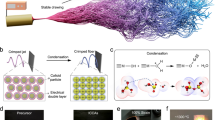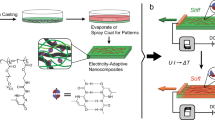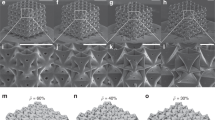Abstract
At micro- and nanoscales, materials with high Young’s moduli and low densities are of great interest for high-frequency micromechanical resonator devices1,2,3,4,5,6,7,8. Incorporating carbon nanotubes (CNTs), with their unmatched properties, has added functionality to many man-made composites9,10,11. We report on the fabrication of ≤100-nm-thick laminates by sputter-deposition of aluminium onto a two-dimensional single-walled CNT network12,13. These nanolaminates—composed of Al, its native oxide Al2O3 and CNTs—are fashioned, in a scalable manner, into suspended doubly clamped micromechanical beams. Dynamic flexural measurements show marked increases in resonant frequencies for nanolaminates with Al–CNT laminae. Such increases, further supported by quasi-static flexural measurements, are partly attributable to enhancements in elastic properties arising from the addition of CNTs. As a consequence, these nanolaminate micromechanical resonators show significant suppression of mechanical nonlinearity and enhanced strength, both of which are advantageous for practical applications and analogous to biological nanocomposites, similarly composed of high-aspect-ratio, mechanically superior mineral platelets in a soft protein matrix14.
This is a preview of subscription content, access via your institution
Access options
Subscribe to this journal
Receive 12 print issues and online access
$259.00 per year
only $21.58 per issue
Buy this article
- Purchase on Springer Link
- Instant access to full article PDF
Prices may be subject to local taxes which are calculated during checkout




Similar content being viewed by others
References
Henry Huang, X. M., Zorman, C. A., Mehregany, M. & Roukes, M. L. Nanoelectromechanical systems: Nanodevice motion at microwave frequencies. Nature 421, 496–496 (2003).
Hutchinson, A. B. et al. Dissipation in nanocrystalline-diamond nanomechanical resonators. Appl. Phys. Lett. 84, 972–974 (2004).
Sazonova, V. et al. A tunable carbon nanotube electromechanical oscillator. Nature 431, 284–287 (2004).
Ekinci, K. L. & Roukes, M. L. Nanoelectromechanical systems. Rev. Sci. Instrum. 76, 061101 (2005).
Aldridge, J. S. & Cleland, A. N. Noise-enabled precision measurements of a Duffing nanomechanical resonator. Phys. Rev. Lett. 94, 156403 (2005).
Bunch, J. S. et al. Electromechanical resonators from graphene sheets. Science 315, 490–493 (2007).
Imboden, M., Mohanty, P., Gaidarzhy, A., Rankin, J. & Sheldon, B. W. Scaling of dissipation in megahertz-range micromechanical diamond oscillators. Appl. Phys. Lett. 90, 173502 (2007).
Verbridge, S. S., Shapiro, D. F., Craighead, H. G. & Parpia, J. M. Macroscopic tuning of nanomechanics: Substrate bending for reversible control of frequency and quality factor of nanostring resonators. Nano Lett. 7, 1728–1735 (2007).
Mamedov, A. A. et al. Molecular design of strong single-wall carbon nanotube/polyelectrolyte multilayer composites. Nature Mater. 1, 190–194 (2002).
Zhan, G.-D., Kuntz, J. D., Wan, J. & Mukherjee, A. K. Single-wall carbon nanotubes as attractive toughening agents in alumina-based nanocomposites. Nature Mater. 2, 38–42 (2003).
Veedu, V. P. et al. Multifunctional composites using reinforced laminae with carbon-nanotube forests. Nature Mater. 5, 457–462 (2006).
Rao, S. G., Huang, L., Setyawan, W. & Hong, S. Nanotube electronics: Large-scale assembly of carbon nanotubes. Nature 425, 36–37 (2003).
Lee, M. et al. Linker-free directed assembly of high-performance integrated devices based on nanotubes and nanowires. Nature Nanotechnol. 1, 66–71 (2006).
Gao, H., Ji, B., Jager, I. L., Arzt, E. & Fratzl, P. Materials become insensitive to flaws at nanoscale: Lessons from nature. Proc. Natl Acad. Sci. USA 100, 5597–5600 (2003).
Fritz, J. et al. Translating biomolecular recognition into nanomechanics. Science 288, 316–318 (2000).
Dorignac, J., Kalinowski, A., Erramilli, S. & Mohanty, P. Dynamical response of nanomechanical oscillators in immiscible viscous fluid for in vitro biomolecular recognition. Phys. Rev. Lett. 96, 186105 (2006).
Badzey, R. L. & Mohanty, P. Coherent signal amplification in bistable nanomechanical oscillators by stochastic resonance. Nature 437, 995–998 (2005).
Shim, S.-B., Imboden, M. & Mohanty, P. Synchronized oscillation in coupled nanomechanical oscillators. Science 316, 95–99 (2007).
Knobel, R. G. & Cleland, A. N. Nanometre-scale displacement sensing using a single electron transistor. Nature 424, 291–293 (2003).
Schwab, K. C. & Roukes, M. L. Putting mechanics into quantum mechanics. Phys. Today 58, 36–42 (2005).
Bishop, D., Heuer, A. & Williams, D. Microelectromechanical systems: Technology and applications. Mater. Res. Soc. Bull. 4, 282 (2001).
Ruoff, R. S. Time, temperature, and load: The flaws of carbon nanotubes. Proc. Natl Acad. Sci. USA 103, 6779–6780 (2006).
Hemker, K. J. & Sharpe, W. N. Microscale characterization of mechanical properties. Annu. Rev. Mater. Res. 37, 93–126 (2007).
Chawla, K. K. in Composite Materials (eds Ilschner, B. & Grant, N. J.) (Springer, Berlin, 1987).
Maranganti, R. & Sharma, P. Length scales at which classical elasticity breaks down for various materials. Phys. Rev. Lett. 98, 195504 (2007).
Shim, S. B. et al. Micromechanical resonators fabricated from lattice-matched and etch-selective GaAs/InGaP/GaAs heterostructures. Appl. Phys. Lett. 91, 133505 (2007).
Samuel, B. A. & Haque, M. A. Room temperature relaxation of freestanding nanocrystalline gold films. J. Micromech. Microeng. 16, 929–934 (2006).
Lachut, M. J. & Sader, J. E. Effect of surface stress on the stiffness of cantilever plates. Phys. Rev. Lett. 99, 206102 (2007).
Xiong, Q., Duarte, N., Tadigadapa, S. & Eklund, P. C. Force–deflection spectroscopy: A new method to determine the Young’s modulus of nanofilaments. Nano Lett. 6, 1904 (2006).
Kaajakari, V., Mattila, T., Oja, A. & Seppa, H. Nonlinear limits for single-crystal silicon microresonators. J. Microelectromech. S 13, 715 (2004).
Acknowledgements
This work is mainly supported by the Seoul R&BD program. S.H. and Y.D.P. are partly supported by MOCIE. K.C. and Y.D.P. are partly supported by Samsung Electronics Corporation and KOSEF though CSCMR. J.H.B. and Y.D.K. would like to thank the Seoul Science Fellowship program; S.H. would like to acknowledge support from the MOST NRL program; M.K. would like to acknowledge KOSEF (ROA-2007-000-10014-0) and Y.D.P. would like to acknowledge the KRF (MOEHRD, Basic Research Promotion Fund) (KRF-2006-311-C00297). We would like to thank S. W. Cho for help with the focused ion beam experiments and W. S. Choi and T. W. Noh for the optical reflectivity measurements.
Author information
Authors and Affiliations
Contributions
J.H.B. conducted the quasi-static flexural measurements with assistance from B.Y.L. and S.H. Y.D.K. conducted the dynamic flexural measurements with assistance from J.H.B. and S.S.H. S.S.H. developed the micromechanical resonator fabrication method with assistance from J.H.B. and Y.D.K. (B.Y.L. and S.H. assembled the CNT network; S.R.L. and K.C. deposited Al). J.H.J. and M.K. conducted the TEM characterizations. Y.D.P. designed the experiment with assistance from J.H.B., Y.D.K. and S.S.H. J.H.B., Y.D.K. and Y.D.P. analysed the data with assistance from S.S.H. Y.D.P. prepared the manuscript with assistance from J.H.B., Y.D.K., S.S.H., M.K., K.C. and S.H.
Corresponding author
Supplementary information
Supplementary Information
Supplementary Figures S1–S15 and Supplementary Tables S1–S2 (PDF 1428 kb)
Rights and permissions
About this article
Cite this article
Bak, J., Kim, Y., Hong, S. et al. High-frequency micromechanical resonators from aluminium–carbon nanotube nanolaminates. Nature Mater 7, 459–463 (2008). https://doi.org/10.1038/nmat2181
Received:
Accepted:
Published:
Issue Date:
DOI: https://doi.org/10.1038/nmat2181
This article is cited by
-
Structural and mechanical properties of magnetron-sputtered Al–Au thin films
Applied Physics A (2017)
-
Integrated devices based on networks of nanotubes and nanowires
NPG Asia Materials (2010)
-
Nanotubes: Resonant reinforcement
NPG Asia Materials (2008)



